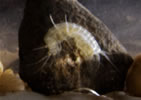Flatworms (Triclads – named after their triple branched gut) are simple white or brown flattened worms that move about their damp habitat by a series of undulations. Most flatworms are free-living in streams and pools, but many are parasitic. None feed on dead or decaying organic material. Although simple they have a bilateral nervous system and the head end of some species even has a rudimentary brain to integrate signals from eyespots. Some have the ability to continue to grow as two flatworms when cut in half - the bit that had the tail grows a new tail and its tail becomes the head. Flatworms need clean water with high levels of oxygen.
To identify the species you need to identify the location and number of eyes, the shape of a flatworm varies depending on when it last ate a meal.
Those in the caves are small and some examples found in Yorkshire are:
Phagocata vitta, 8-12mm, a white species with 2 eyes set close together, recorded from Birkwith Cave, Tatum Wife Hole, Short Drop and on the dark cobbles in County Pot and Pool Sink. It feeds on oligochaetes, amphipods (e.g. Gammarus) and chironomids. P vitta is commonly found in springs, headwaters of streams and below ground. Smaller numbers are found in oligotrophic rivers.
|
Flatworm Phagocatta vitta, Pool Sink. The two eyes can be seen. |
Crenobia alpina, 8-12mm, grey-coloured with two eyes is recorded from County Pot, Scoska Cave, and Crenobia Inlet in Sell Gill Holes. It is a characteristic species of cool, flowing water, and is found on the undersides of stones in small streams. It is less likely to be found in sluggish streams. C alpina feeds on oligochaetes, amphipods (e.g. Gammarus pulex), chironomids, Plecoptera (stonefly nymphs) and Trichopterans (caddisfly larvae). Crenobia Inlet in Sell Gill Hole is named after this species.
C. alpina and P. vitta are intolerant of summer temperatures and so prefer to live in caves and cool mountain streams, they are the species most likely to be encountered near the source of streams. They breed both sexually and asexually (by fission).
Dendrocoeleum lacteum, 14-25mm, is a larger, white, predatory species and is recorded from Lost Johns. It prefers to feed on Asellus but also feeds on amphipods (Gammarus pulex) and oligochaetes. It is relatively big and fast (for a flatworm) and has a pseudo-sucker to help capture prey. It breeds in the spring and dies in the summer after producing cocoons.
Microturbellarians belong to another order of flatworms consisting of many small species. Often white in colour, many live head to tail in chains.
|


.jpg)